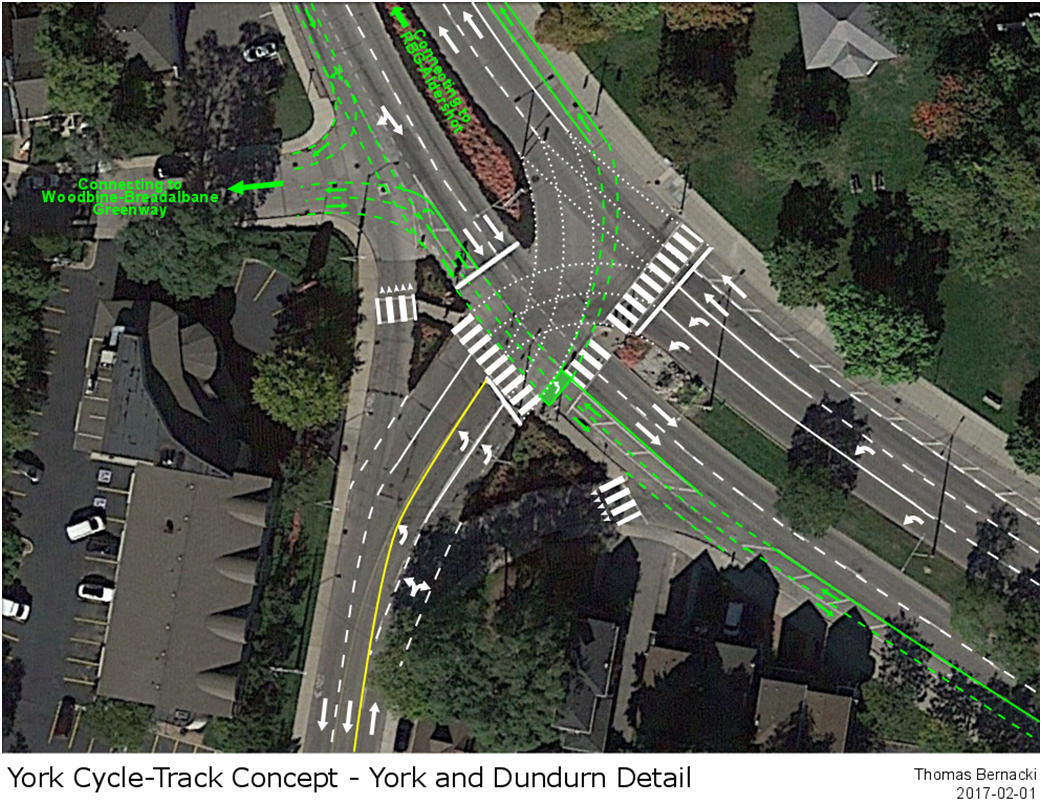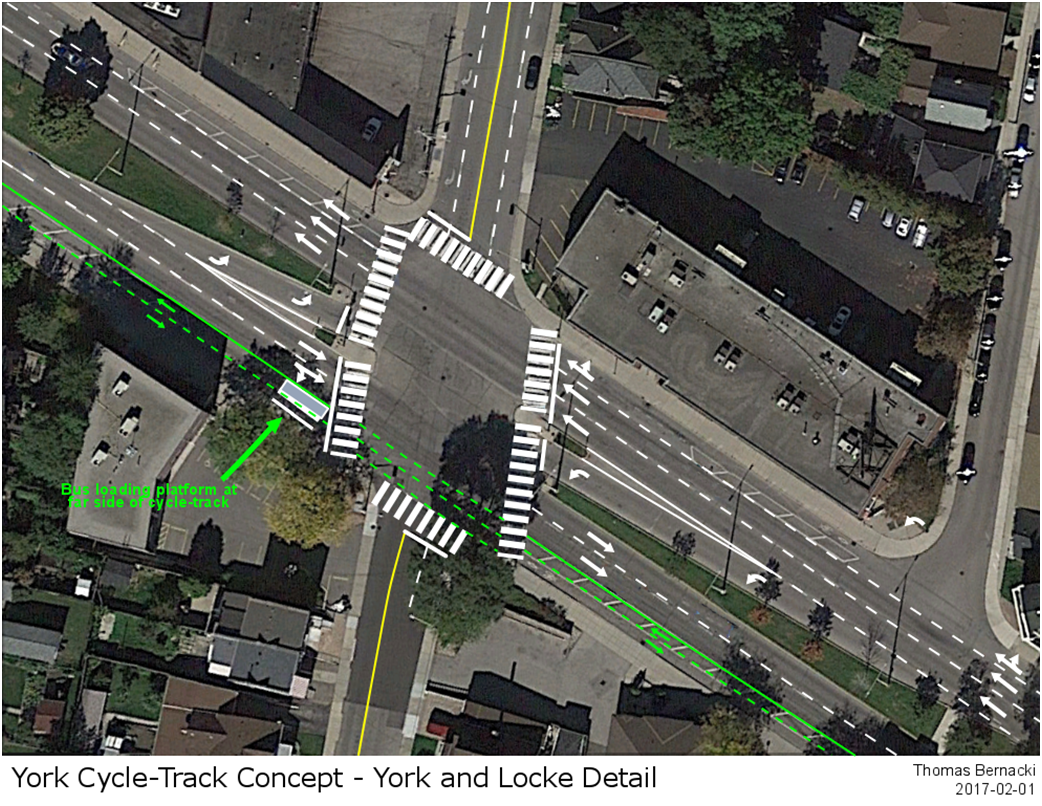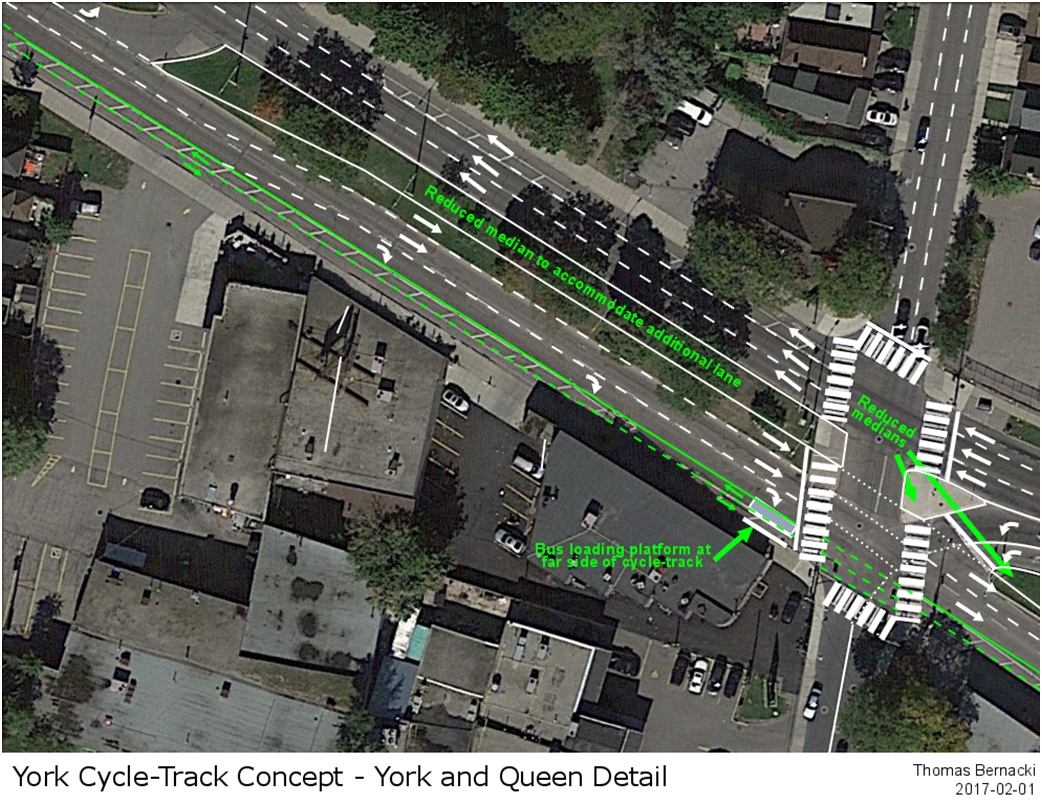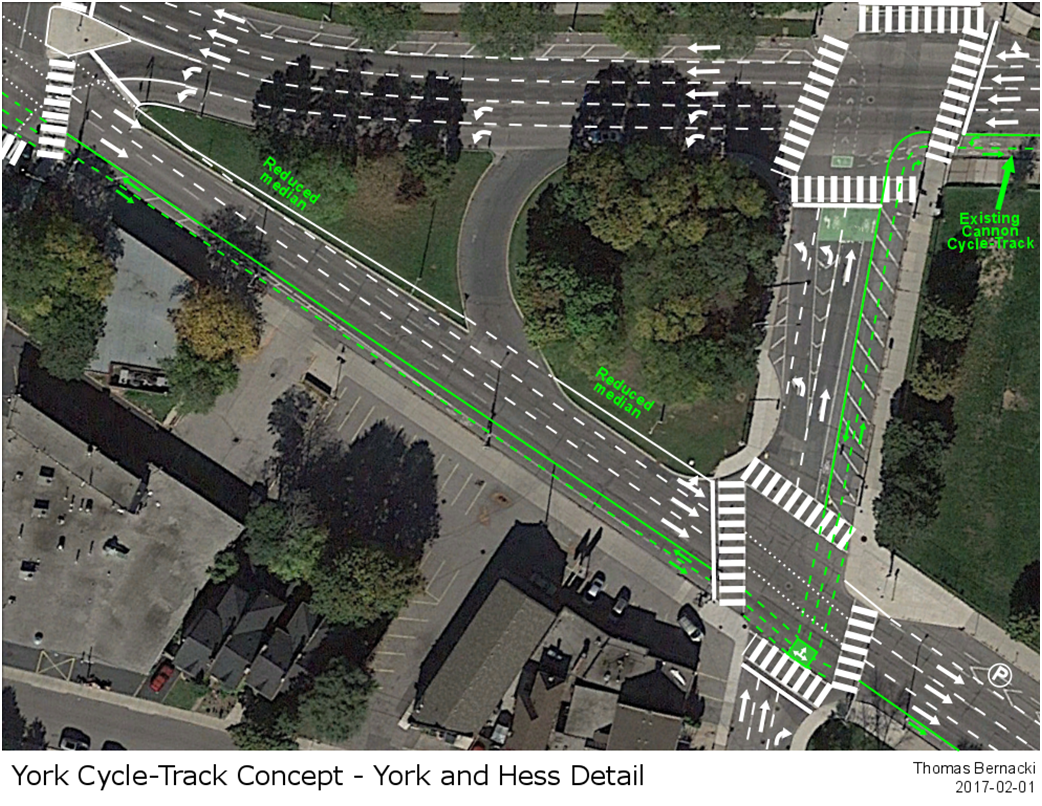Given the constraints presented, I want to illustrate to engineers and staff, as a starting point for further discussion, that a replacement for lost cycling infrastructure is feasible using the southernmost lane along York.
By Thomas Bernacki
Published February 07, 2017
Following a review of the material presented at the Public Information Centre #2 for the Hamilton Light Rail Transit (LRT) project, I had an opportunity to chat at length with some of the assembled engineering consultants and city staff.
As a daily user of the York Boulevard bike lanes, and as a parent who walks his kids to school down Dundurn Street, but also as a supporter of the LRT project, I wanted to be sure I understood the motivation behind the proposed removal of the bike lanes on York and Dundurn.
By the end of the discussion, traffic engineers more-or-less said that one extra westbound lane on York, and one extra southbound lane on Dundurn were going to be pretty firm constraints. When I asked about keeping bike lanes in the eastbound lanes of York, it was suggested that right-turn "stacking" from York onto Queen would also be problematic.
To be clear, I don't agree with the base assumption behind the modeling that overall traffic volumes will rise throughout the period of LRT operation. RTH has documented well the notion that we are past the point of "peak car".
So the idea that we need to fully accommodate all traffic displaced by LRT - and then some - while we build the means to reduce car trips, is in my mind planning for failure.
That being said, as an engineer, I can appreciate what we're up against when the opposition comes armed with models and numbers.
So, given the constraints presented, I wanted to be able to illustrate to engineers and staff, as a starting point for further discussion, that a replacement for lost cycling infrastructure was feasible using the southernmost lane along York.
Illustrations depicting a possible configuration for a two-way protected cycle track along York are shown below.

York and Dundurn
The proposed contra-flow lanes start with a connection to the proposed Woodbine-Breadalbane greenway, which Ryan McGreal detailed in a previous RTH article.
Here the lane coming from the direction of the RBG can continue onto either the greenway or the cycle track. Bike traffic westbound from downtown is either guided onto the greenway, or a bike box facilitates connection to the westbound lane to the RBG. Right-hand turn car lanes cross the bike lanes in a similar fashion to present.
With increased car traffic at the intersection, improved pedestrian spaces are critical, and I propose adding zebra crossings, and what I feel should be standard at all off-ramp-style slip-lanes, speed-tables, or raised crosswalks.
The existing road widths support two turning lanes from York to Dundurn, and two southbound lanes and one northbound lane on Dundurn. I vehemently oppose the widening of Dundurn suggested by the posters at the public meeting, as the additional traffic will already reduce safety.

York and Locke
The contra-flow protected bike-lanes continue along the south leg of York. Three lanes of westbound traffic is accommodated on the north leg of York.
Bus stops are accommodated in the same manner as the bus stop at Macklin and King, where the two-way cycle track crosses the bus loading area, and a concrete platform is located on the far side of the cycle track from the sidewalk.
This eliminates buses stopping in the bike lanes, as is currently the case on the York bike lanes.

York and Queen
The pattern presented in the previous figure continues. However, starting around Ray Street, the median is narrowed to permit an additional lane at the intersection of Queen. This permits a dedicated right-hand car turning lane that does not directly interfere with the cycle track, with two lanes straight through.
The bus stop at Queen (as with all bus stops along the route) is accommodated with a loading platform on the other side of the cycle track, as is currently done at Macklin and King.

York and Hess
Between Queen and Hess, there is currently room allocated for one eastbound bike lane. Turning this into a two-way track while retaining the other car traffic lanes would require reducing the medians by half a lane's width.
A bike box at Hess accommodates the northward connection (along the massive unused portion of Hess) to connect with the existing Cannon Street cycle track. Eastbound from here along York would remain unchanged.
LRT staff indicate that further consultation will be scheduled with the cycling community and neighbourhood associations in respect of replacing cycling infrastructure impacted by the LRT project. They have stated that they are looking for "creative solutions" to provide a one-for-one replacement for lost cycling infrastructure.
I present the above proposal as a starting point for discussion for replacing cycling infrastructure on York, while meeting constraints that I believe traffic engineers will ultimately insist on.
While a Woodbine-Breadalbane greenway is not exactly a one-for-one replacement for the Dundurn bike lanes (should they be removed), in total I believe the combination of a greenway with improved lanes on York is a net improvement.
One location unaddressed in this proposal is the most direct Westdale-Downtown cycling route, following Hunt-Head-Napier through the Strathcona neighbourhood. If the Dundurn lanes are removed, that connection is effectively broken, especially with additional traffic lanes potentially being added to Dundurn.
I inquired with planning staff about facilitating an improved cycling connection via the proposed suburban-style Shopper's and Tim Hortons drive-through development at King and Dundurn, but I was informed that the site plan had been recently approved.
Here's hoping the adjacent LRT stop gives the developers reason to consider a design more suitable for its urban context, perhaps in line with the Strathcona Secondary Plan.
Failing a re-opening of the design, I cannot see a way to replace that connection should the Dundurn bike lanes be removed. I hope further creative thinking can help find a solution.
By JasonL (registered) | Posted February 07, 2017 at 09:34:36
Well done Thomas. The visuals are great and this whole presentation is very well thought-out.
As another Strathcona resident one of my biggest concerns that so far hasn't been spoken of, is the walkability of any changes made to our streets. This is a very pedestrian oriented neighbourhood. We have a rather low rate of car ownership compared to most areas in the city.
The changes to Dundurn and York a few years ago were a fantastic step forward in slightly improving safety for the huge mix of folks who walk in this part of the city. I don't have any appetite in 2017 for York to go back to 5 WB lanes near Hess, or Dundurn to revert to 3 lanes.
I plan on pushing for Main St to be converted to 2-way instead of all this other stuff.
Many cities, recognizing that the future isn't in single occupant cars, are narrowing roads and flat out removing some in order to dramatically shift their transport options. I'd love to see Hamilton follow the lead of the most successful cities around the world and do the same.
Comment edited by JasonL on 2017-02-07 10:45:21
By Tecumseh (registered) | Posted February 07, 2017 at 21:04:21 in reply to Comment 120705
Thanks Jason. I agree fully on walkability: these are the streets I walk with my wife and kids. As a city we really should be ambitious and plan for success in reducing car trips. I remember Dundurn only a few years ago, with 50 kph+ traffic whipping past just inches away. And even more recently on York, albeit with wide sidewalks being some help. So my first preference that I stated in my formal feedback to the PIC was to convert Main to 2-way, and leave traffic alone on York and Dundurn! But failing that, being pragmatic, I wanted to have some feedback ready should the traffic engineers get their way.
But clearly there's room to de-prioritize cars from our street network! Doing these illustrations really made it clear how much so - just look at the York-Hess figure. Even with the improved cycling infrastructure, that whole area is just a sea of car lanes. -- Thomas Bernacki
By beesplease (registered) | Posted February 07, 2017 at 09:44:27
It sure would be great to have a decent cycling route that continues to the RBG... One that doesn't involve sprinting across the highway on-ramp or hauling your bike up the trough at the DesJardins Canal, and back down again...
By Sara (registered) | Posted February 07, 2017 at 10:20:33
Thanks Thomas for this excellent post and drawings.
Here are some related ideas:
1) The "breaking" of the Head-Hunt-Napier routes because of LRT and heavier traffic on Dundurn - I'm not certain what you mean by that... But my guess is you mean that without a bike lane on Dundurn N it becomes unsafe for cyclists to cross Dundurn from Head to Hunt as the street are staggered. This is one of my biggest concerns with losing the Dundurn N bike lane. I wonder if we can convince the city to make Head, Hunt, Dundurn as one large signalised intersection area, activated by pedestrians or cyclists wanting to cross Dundurn. That way the Head-Hunt-Napier connection can be maintained and even safer than it currently is.
2) City is building in the next few months a path around Bascilica at 403 that would connect with current Kay Drage Park tunnel under 403. This will get some cyclist traffic, perhaps especially form cyclists who want to avoid King and 403. But it won't be a great commuter route as it is quite circuitous. I wonder though if there could be a longer term plan to propose to the city to build a bridge over or tunnel under the CP rail tracks that separate Kay Drage park from Strathcona (connecting perhaps at the end of Jones St or Lochearne). The multi-use trail would need to be matched with a connection between Macklin and Freeland Court in Westdale(perhaps a short set of stairs with a bike through). This would create a direct, safe, excellent connection between Strathcona and Westdale, and make the York bike route even more popular as it could become a main bike thru way from McMaster to Downtown. (One caveat is there may be some concerns that the elevation changes would make it not popular even though it would be direct.)
3) If you're interested in finding out more about the plans for the Tims/Shoppers land, here's one update - not sure what's happening at the OMB: https://www.raisethehammer.org/article/2...
4) Just FYI, bike boxes are a bit more complex than what is shown in your sketch - they can't be placed in the direct path of a bike lane as bikes not using it (ie going straight, not turning) need to have a clear path without bikes waiting for the other light in their way. Any bike box needs to be set back from the bikelane between the bike lane and car stop line (or on streets with parking - set in line with the parking lane).
Comment edited by Sara on 2017-02-07 10:59:52
By Pxtl (registered) - website | Posted February 08, 2017 at 12:07:02 in reply to Comment 120708
I wonder if we can convince the city to make Head, Hunt, Dundurn as one large signalised intersection area, activated by pedestrians or cyclists wanting to cross Dundurn. That way the Head-Hunt-Napier connection can be maintained and even safer than it currently is.
It's important to note that a large amount of buildings between King, Dundurn, and Head are set to be demolished for a new Shoppers Drug Mart, townhouses, and a Tim's drive-through.
See here:
https://www.raisethehammer.org/article/2...
If the city could work with the developer we could get an off-street connection from Hunt to Head. Unfortunately as mentioned in the article the developer was already fighting for permits through the OMB so they may not be amenable to city "requests".
Article is from 2014, I don't know where things stand now.
Comment edited by Pxtl on 2017-02-08 12:11:09
By Tecumseh (registered) | Posted February 07, 2017 at 21:16:12 in reply to Comment 120708
Thanks for the feedback Sara! You're right about my interpretation of that intersection. With the offset, once the Dundurn lanes are gone I really wouldn't see it as an effective bike route anymore. Now I ride in mixed traffic, but most won't, and I certainly wouldn't ride with my kids across Dundurn there with no cycling infrastructure. I think your idea about the signalized crossing would fix it. And I look forward to seeing more about the connections to Kay Drage! And I knew something was off with how I indicated the bike boxes, thanks for clearing that up. I'm sure there's a way to fit bike boxes at those intersections in the safest possible way.
This is exactly the sort of discussion I was hoping to stimulate with the design, thanks for chipping in! Hopefully when LRT staff come back for comment from the community all these voices are there to help build something brilliant! --Thomas Bernacki
By kevinlove (registered) | Posted February 07, 2017 at 14:19:30
A big "thank you" to Thomas for being a caring and engaged citizen. This design must have taken a lot of work! I am reluctant to criticize it, and must start by saying that I really truly appreciate Thomas' effort, concern and caring for the city in which we live. My concerns are technical engineering concerns only.
Having said that, I do have two technical engineering concerns. These concerns are about two ways in which the proposed design is dangerous because it has violated the CROW Design Manual for Bicycle Traffic.
The first concern is that it puts a bi-directional cycle track in an area with level crossing intersections used by motor vehicles. Bi-directional cycle tracks are only appropriate when there are no level crossing intersections used by motor vehicles. Examples include being up against a natural obstacle such as a lake, harbour or the Niagara Escarpment. Or being in a protected environment from which motor vehicles are excluded, such as the Escarpment Rail-Trail. Here is a good explanation of the problems that can be caused by an inappropriate bi-directional cycle track.
The other issue is the inappropriate use of Advanced Start Lines, or so-called "bike boxes." This infrastructure is obsolete, as there are much better and safer ways of reducing intersection conflicts, as set out in the CROW manual. David Hembrow has a good explanation of the problems that can be caused by this obsolete infrastructure design.
Most unfortunately, the CROW manual is not available on-line, and purchasing a hard copy will set you back an eye-popping 129 Euros. It is a tool for professional engineers, and priced accordingly.
By Tecumseh (registered) | Posted February 07, 2017 at 21:28:21 in reply to Comment 120713
I'm curious about your thoughts on the Cannon bi-directional lanes. I for one am glad they are there... better than no lanes at all, at least in my mind. I've ridden the Cannon lanes with my kids and didn't feel unsafe at all. Any thoughts on how my proposed York design could be better in light of your suggestions? --Thomas Bernacki
By KevinLove (registered) | Posted February 08, 2017 at 12:58:01 in reply to Comment 120722
Dear Thomas,
Thank you once again for your proposed York design. I have already published an article commending the Eglinton Crosstown LRT in Toronto as a good example of how to integrate LRT and protected cycling infrastructure.
A key issue is intersections, but fortunately all the work has already been done for us. Intersection design is Chapter 6 in the CROW manual, from pages 183 to 290. All that it is necessary to do is pick the appropriate intersection design and apply it. And do not, do not, do not ever attempt to re-invent the wheel by deviating from the authorized designs. This is the difference between amateur and professional engineers: Professionals are unlikely to "just wing it" because they realize that the design standards have been put together by the top experts in this area.
As to Cannon Street, yes, this is certainly better than nothing. But that is not how safety works. The Ministry of Labour disapproves of attempts to run a factory in Hamilton with workers separated from dangerous moving machinery by nothing more than a line of paint. And if I attempt to tell the Ministry inspectors, "but that is better than nothing," then I can expect to see my factory immediately shut down.
Among other things, Cannon Street is a residential street, with many children living on this street. It is completely inappropriate and unsafe to have rat-running "cut-through" motor vehicle traffic on a residential street. This inappropriate and unsafe practice has been virtually eliminated in The Netherlands. For details, please see this text and video.
Key quotation from the linked website: "Residential streets in the Netherlands rarely work as through roads for cars, even if they were originally designed to do so."
Unfortunately, we are still dealing with that "originally designed" situation here in Hamilton. This was fixed in virtually every residential street in The Netherlands. An entire country fixed this problem. We can too!
By Tecumseh (registered) | Posted February 08, 2017 at 19:17:05 in reply to Comment 120727
Would I take a proper Dutch CROW design over the one I proposed? You bet! I agree with you 100% on the safety of our streets, as compared to our workplaces for instance, as you point out. (Some days I ask myself how we ever decided cars were a good idea on our city streets in the first place, which for the majority of human history were true public spaces.)
So in my feedback to LRT staff my first preference was to NOT add traffic lanes back, and to consider 2-way conversion of Main St instead. We should not be moving backwards in that respect.
But as much as I agree with you Kevin, there are probably on the order of hundreds of thousands of people in the city who disagree with us on the importance of safely accommodating all modes of transportation on all streets. So maybe I'm pessimistically hedging my bets in presenting a starting point for discussion that assumes traffic engineers will get their way on accommodating additional car traffic. But if applying best practices at every instance was realistic (politically, economically, physically, etc.), there would be far less need for engineers. I'd suggest engineers are precisely most necessary when competing constraints are present, and a solution that is not pre-made needs to be, well, engineered. Without knowing the full scope of constraints at play here, and hearing from all stakeholders, it's not really possible to know what can work for the community, and what can fly politically (let alone get an engineering design that navigates all of that too). Anyway, I hope once the LRT staff come back to the community for input your voice is there too Kevin, because maybe we should be aiming higher than the idea I've presented here for consideration.
By KevinLove (registered) | Posted February 09, 2017 at 11:47:18 in reply to Comment 120728
I'd suggest engineers are precisely most necessary when competing constraints are present
We need professional engineers with a code of ethics which holds that safety is NOT a constraint. Suppose a civil engineer produces a bridge design which, due to budget constraints, will only collapse on rare occasions. When was the last time we heard a civil engineer say about his bridge design, "only once in the last 50 years have we had an ice storm severe enough that the ice buildup will cause this bridge to collapse"?
The correct answer to that question is "never."
Similarly, no professional engineer should ever be involved in a traffic design that is unsafe because it fails to conform to established design engineering standards. Standards such as CROW. If anyone does so, then that is professional malfeasance. Such a person should be severely disciplined. In my opinion, being expelled from Professional Engineers Ontario is an appropriate level of disciplinary response to this professional malfeasance, due to the danger to human life.
Comment edited by KevinLove on 2017-02-09 11:56:04
By AP (registered) | Posted February 07, 2017 at 19:28:30
Thomas (and commenters): Thank you for kicking us off. The success of citizen engagement in the Herkimer/Charlton bike lane designs (big thanks to those who engaged on our behalf!) is well underway to being replicated here. Thank you for leading the way - an idea needs to be shared before it can be refined :)
By Tecumseh (registered) | Posted February 07, 2017 at 21:31:23 in reply to Comment 120716
Thank you! And I agree - I hope my initial suggestion just gets the ball rolling on engagement! So much experience and creativity to draw from. --Thomas Bernacki
By Pxtl (registered) - website | Posted February 08, 2017 at 12:03:09
I really like this one. The addition of right turn lanes make me feel a lot better about the chief problem of a right-side cycle track, which creates bidirectional oncoming traffic in an unexpected place. A right turn lane means that if special signage or signals are needed, there's a place to direct them.
That said, the cost of reducing medians could be prohibitive, and the right turns at minor intersections like Pearl and Strathcona haven't been managed.
Comment edited by Pxtl on 2017-02-08 12:04:14
You must be logged in to comment.
There are no upcoming events right now.
Why not post one?